Strategic Management Report: A Competitive Analysis of Apple Inc.
VerifiedAdded on 2023/06/10
|5
|964
|123
Report
AI Summary
This report provides a competitive analysis of Apple Inc., a multinational technology conglomerate, using Porter's Five Forces model. It examines the competitive rivalry Apple faces from brands like Samsung and LG, the bargaining power of buyers with low switching costs, and the high number of suppliers in the tech industry. The analysis considers the threat of substitute products, the challenges for new entrants due to established brand capitalization, and the interconnectedness of these forces. The report emphasizes that Apple must enhance its competitiveness by continuous innovation to maintain its advantage, focusing on quality and customer satisfaction, while minimizing concerns about new market entrants. Desklib offers a range of solved assignments and study resources for students.
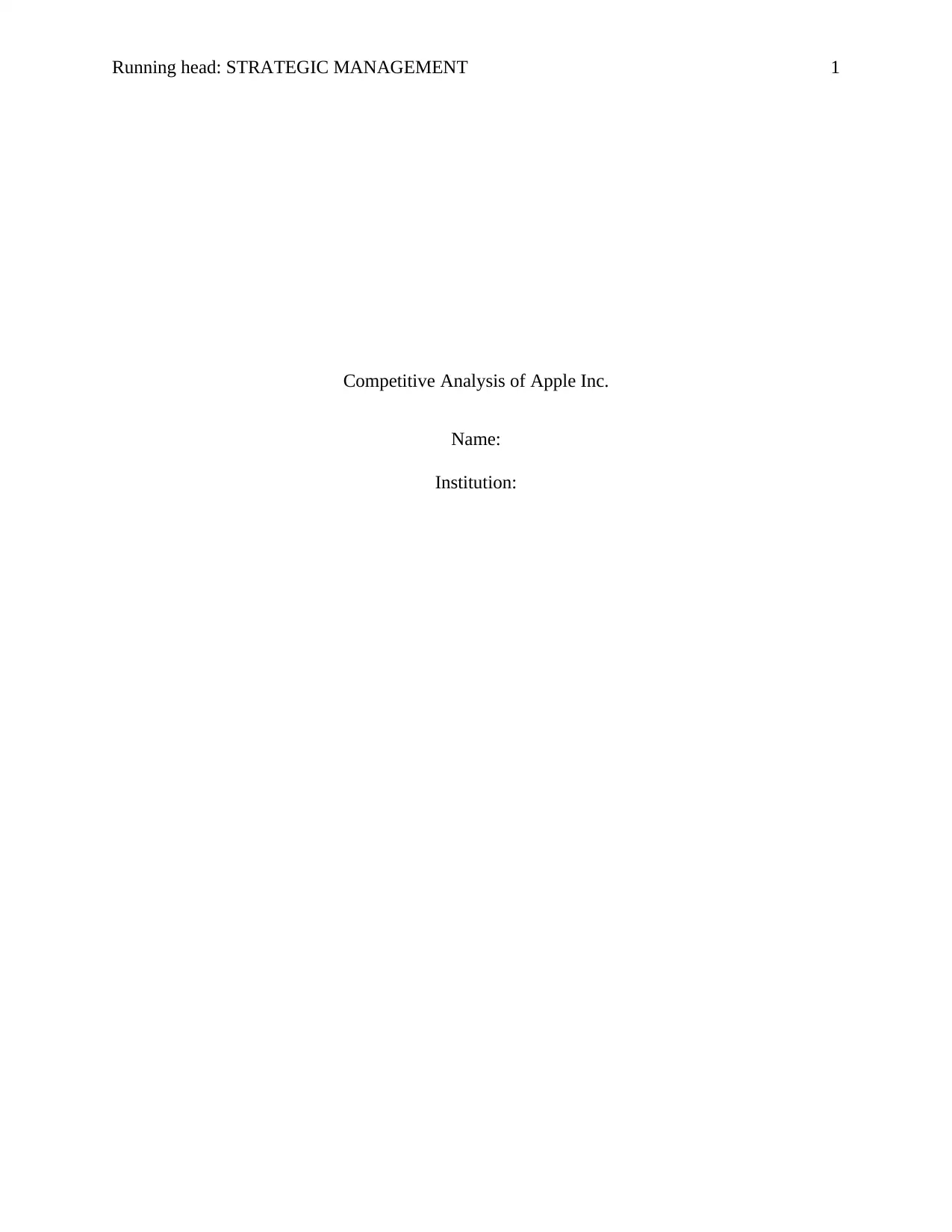
Running head: STRATEGIC MANAGEMENT 1
Competitive Analysis of Apple Inc.
Name:
Institution:
Competitive Analysis of Apple Inc.
Name:
Institution:
Paraphrase This Document
Need a fresh take? Get an instant paraphrase of this document with our AI Paraphraser
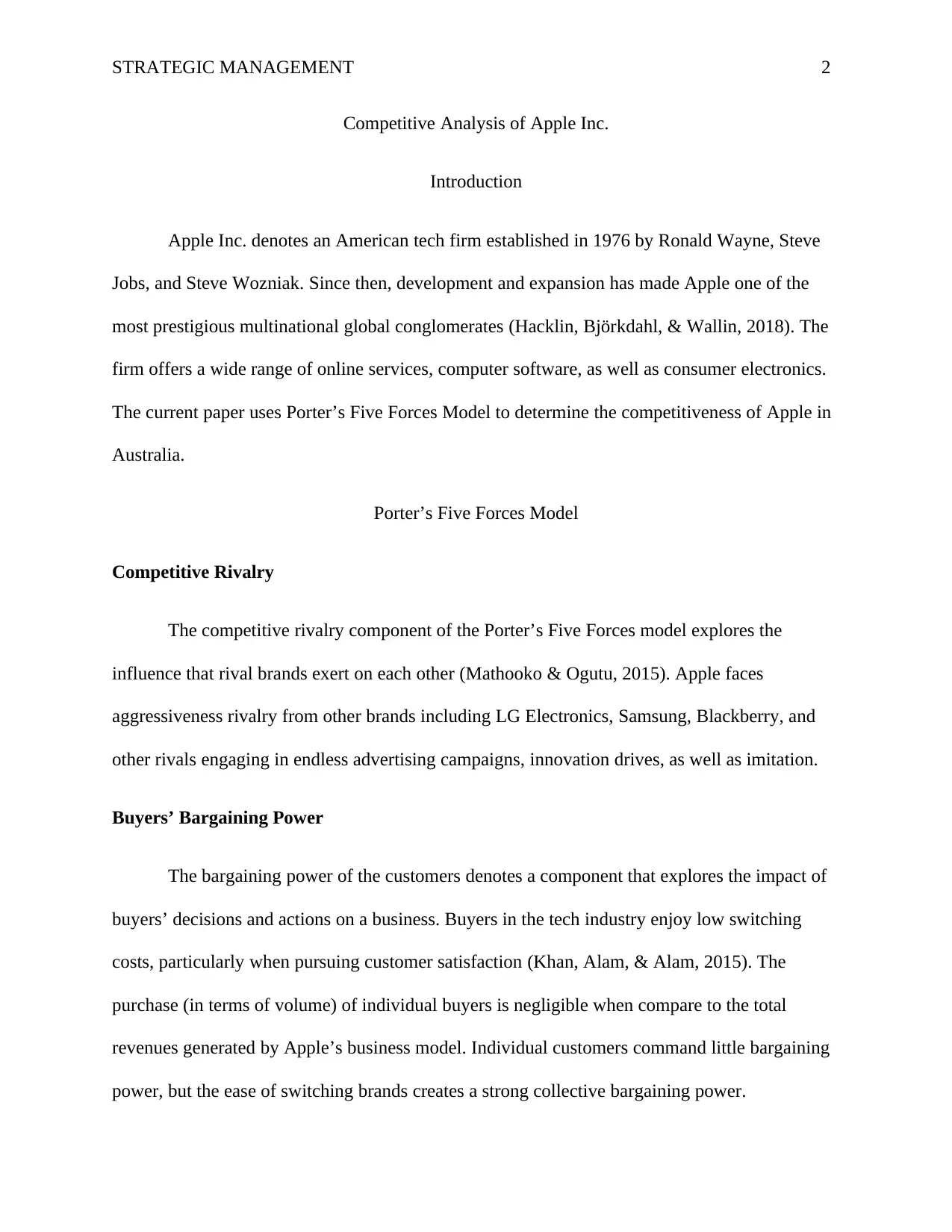
STRATEGIC MANAGEMENT 2
Competitive Analysis of Apple Inc.
Introduction
Apple Inc. denotes an American tech firm established in 1976 by Ronald Wayne, Steve
Jobs, and Steve Wozniak. Since then, development and expansion has made Apple one of the
most prestigious multinational global conglomerates (Hacklin, Björkdahl, & Wallin, 2018). The
firm offers a wide range of online services, computer software, as well as consumer electronics.
The current paper uses Porter’s Five Forces Model to determine the competitiveness of Apple in
Australia.
Porter’s Five Forces Model
Competitive Rivalry
The competitive rivalry component of the Porter’s Five Forces model explores the
influence that rival brands exert on each other (Mathooko & Ogutu, 2015). Apple faces
aggressiveness rivalry from other brands including LG Electronics, Samsung, Blackberry, and
other rivals engaging in endless advertising campaigns, innovation drives, as well as imitation.
Buyers’ Bargaining Power
The bargaining power of the customers denotes a component that explores the impact of
buyers’ decisions and actions on a business. Buyers in the tech industry enjoy low switching
costs, particularly when pursuing customer satisfaction (Khan, Alam, & Alam, 2015). The
purchase (in terms of volume) of individual buyers is negligible when compare to the total
revenues generated by Apple’s business model. Individual customers command little bargaining
power, but the ease of switching brands creates a strong collective bargaining power.
Competitive Analysis of Apple Inc.
Introduction
Apple Inc. denotes an American tech firm established in 1976 by Ronald Wayne, Steve
Jobs, and Steve Wozniak. Since then, development and expansion has made Apple one of the
most prestigious multinational global conglomerates (Hacklin, Björkdahl, & Wallin, 2018). The
firm offers a wide range of online services, computer software, as well as consumer electronics.
The current paper uses Porter’s Five Forces Model to determine the competitiveness of Apple in
Australia.
Porter’s Five Forces Model
Competitive Rivalry
The competitive rivalry component of the Porter’s Five Forces model explores the
influence that rival brands exert on each other (Mathooko & Ogutu, 2015). Apple faces
aggressiveness rivalry from other brands including LG Electronics, Samsung, Blackberry, and
other rivals engaging in endless advertising campaigns, innovation drives, as well as imitation.
Buyers’ Bargaining Power
The bargaining power of the customers denotes a component that explores the impact of
buyers’ decisions and actions on a business. Buyers in the tech industry enjoy low switching
costs, particularly when pursuing customer satisfaction (Khan, Alam, & Alam, 2015). The
purchase (in terms of volume) of individual buyers is negligible when compare to the total
revenues generated by Apple’s business model. Individual customers command little bargaining
power, but the ease of switching brands creates a strong collective bargaining power.
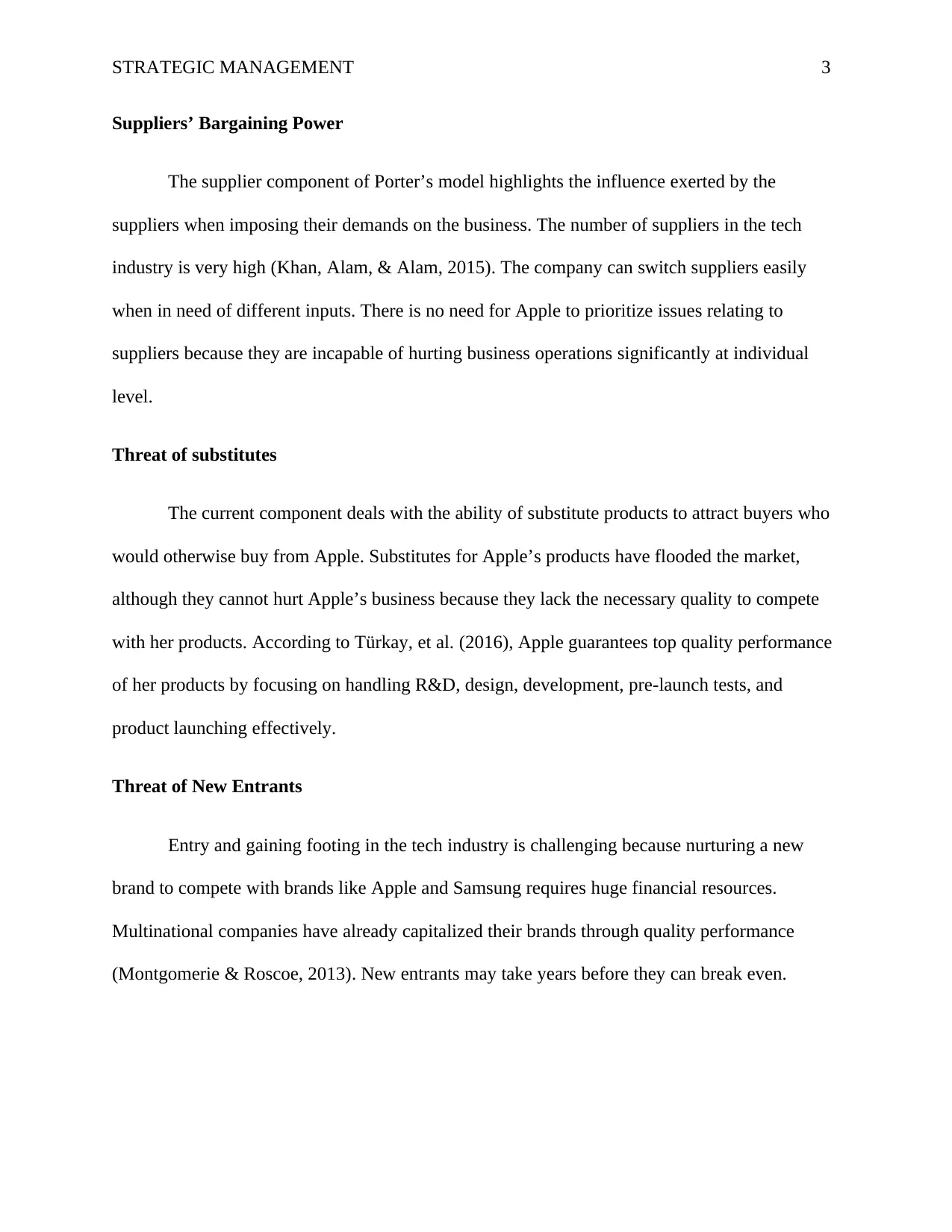
STRATEGIC MANAGEMENT 3
Suppliers’ Bargaining Power
The supplier component of Porter’s model highlights the influence exerted by the
suppliers when imposing their demands on the business. The number of suppliers in the tech
industry is very high (Khan, Alam, & Alam, 2015). The company can switch suppliers easily
when in need of different inputs. There is no need for Apple to prioritize issues relating to
suppliers because they are incapable of hurting business operations significantly at individual
level.
Threat of substitutes
The current component deals with the ability of substitute products to attract buyers who
would otherwise buy from Apple. Substitutes for Apple’s products have flooded the market,
although they cannot hurt Apple’s business because they lack the necessary quality to compete
with her products. According to Türkay, et al. (2016), Apple guarantees top quality performance
of her products by focusing on handling R&D, design, development, pre-launch tests, and
product launching effectively.
Threat of New Entrants
Entry and gaining footing in the tech industry is challenging because nurturing a new
brand to compete with brands like Apple and Samsung requires huge financial resources.
Multinational companies have already capitalized their brands through quality performance
(Montgomerie & Roscoe, 2013). New entrants may take years before they can break even.
Suppliers’ Bargaining Power
The supplier component of Porter’s model highlights the influence exerted by the
suppliers when imposing their demands on the business. The number of suppliers in the tech
industry is very high (Khan, Alam, & Alam, 2015). The company can switch suppliers easily
when in need of different inputs. There is no need for Apple to prioritize issues relating to
suppliers because they are incapable of hurting business operations significantly at individual
level.
Threat of substitutes
The current component deals with the ability of substitute products to attract buyers who
would otherwise buy from Apple. Substitutes for Apple’s products have flooded the market,
although they cannot hurt Apple’s business because they lack the necessary quality to compete
with her products. According to Türkay, et al. (2016), Apple guarantees top quality performance
of her products by focusing on handling R&D, design, development, pre-launch tests, and
product launching effectively.
Threat of New Entrants
Entry and gaining footing in the tech industry is challenging because nurturing a new
brand to compete with brands like Apple and Samsung requires huge financial resources.
Multinational companies have already capitalized their brands through quality performance
(Montgomerie & Roscoe, 2013). New entrants may take years before they can break even.
⊘ This is a preview!⊘
Do you want full access?
Subscribe today to unlock all pages.

Trusted by 1+ million students worldwide
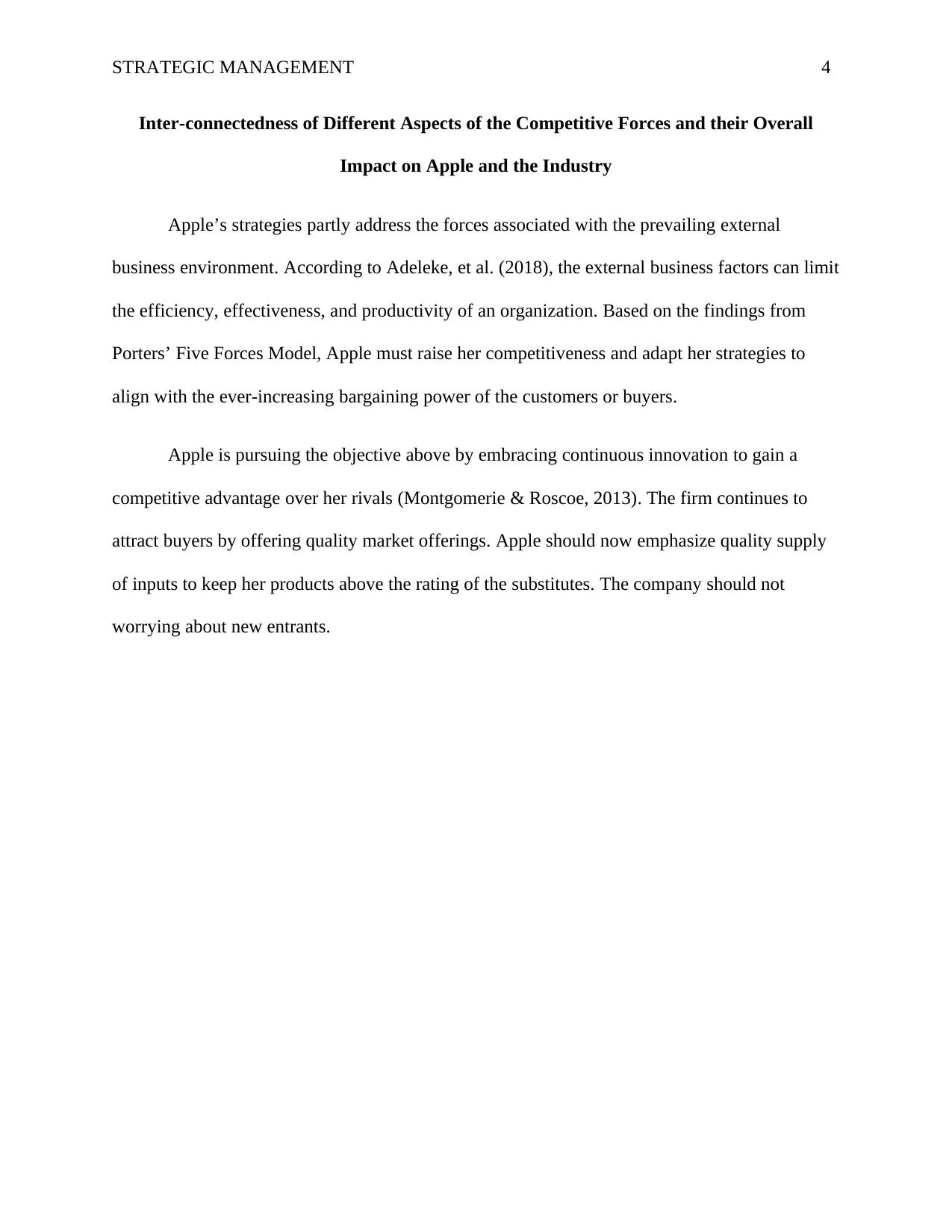
STRATEGIC MANAGEMENT 4
Inter-connectedness of Different Aspects of the Competitive Forces and their Overall
Impact on Apple and the Industry
Apple’s strategies partly address the forces associated with the prevailing external
business environment. According to Adeleke, et al. (2018), the external business factors can limit
the efficiency, effectiveness, and productivity of an organization. Based on the findings from
Porters’ Five Forces Model, Apple must raise her competitiveness and adapt her strategies to
align with the ever-increasing bargaining power of the customers or buyers.
Apple is pursuing the objective above by embracing continuous innovation to gain a
competitive advantage over her rivals (Montgomerie & Roscoe, 2013). The firm continues to
attract buyers by offering quality market offerings. Apple should now emphasize quality supply
of inputs to keep her products above the rating of the substitutes. The company should not
worrying about new entrants.
Inter-connectedness of Different Aspects of the Competitive Forces and their Overall
Impact on Apple and the Industry
Apple’s strategies partly address the forces associated with the prevailing external
business environment. According to Adeleke, et al. (2018), the external business factors can limit
the efficiency, effectiveness, and productivity of an organization. Based on the findings from
Porters’ Five Forces Model, Apple must raise her competitiveness and adapt her strategies to
align with the ever-increasing bargaining power of the customers or buyers.
Apple is pursuing the objective above by embracing continuous innovation to gain a
competitive advantage over her rivals (Montgomerie & Roscoe, 2013). The firm continues to
attract buyers by offering quality market offerings. Apple should now emphasize quality supply
of inputs to keep her products above the rating of the substitutes. The company should not
worrying about new entrants.
Paraphrase This Document
Need a fresh take? Get an instant paraphrase of this document with our AI Paraphraser
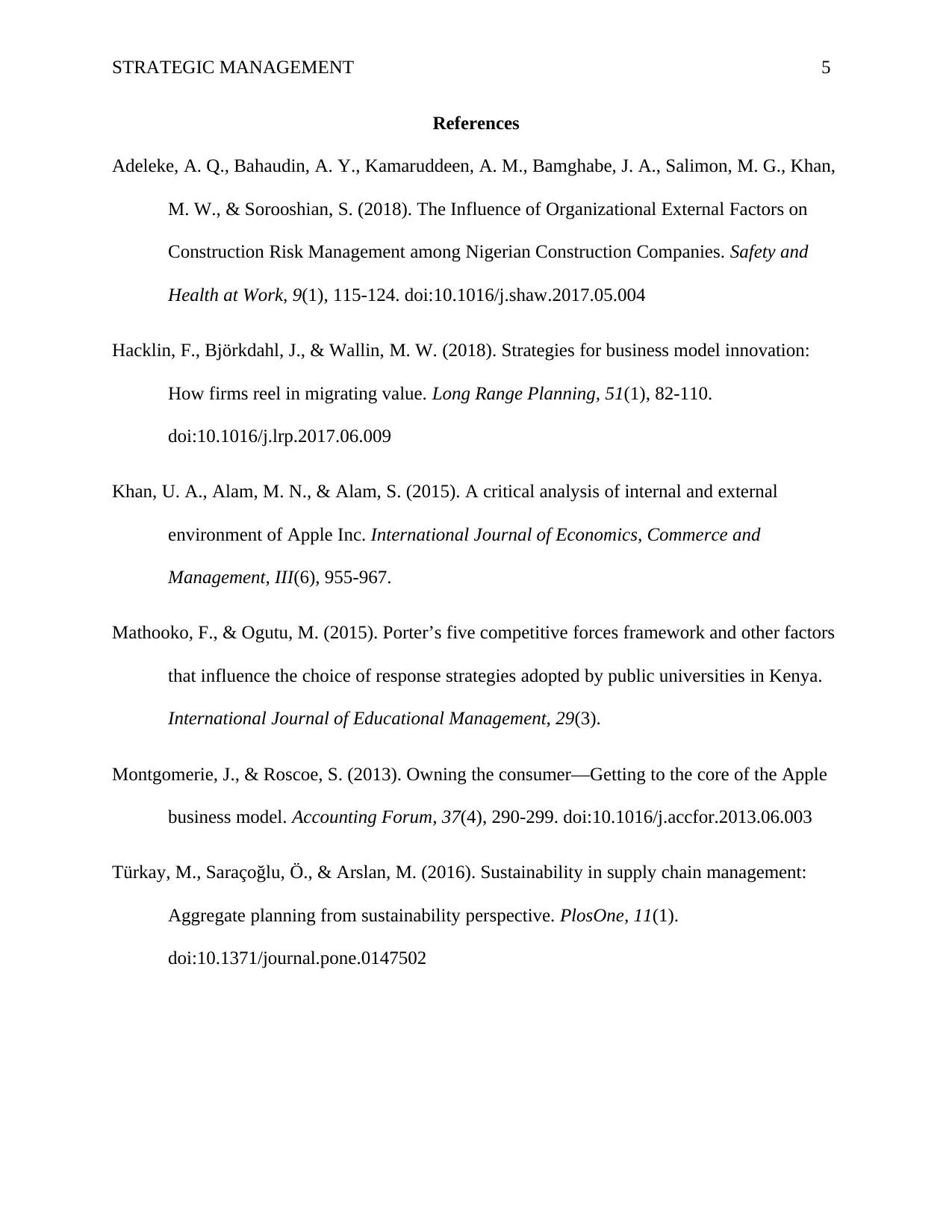
STRATEGIC MANAGEMENT 5
References
Adeleke, A. Q., Bahaudin, A. Y., Kamaruddeen, A. M., Bamghabe, J. A., Salimon, M. G., Khan,
M. W., & Sorooshian, S. (2018). The Influence of Organizational External Factors on
Construction Risk Management among Nigerian Construction Companies. Safety and
Health at Work, 9(1), 115-124. doi:10.1016/j.shaw.2017.05.004
Hacklin, F., Björkdahl, J., & Wallin, M. W. (2018). Strategies for business model innovation:
How firms reel in migrating value. Long Range Planning, 51(1), 82-110.
doi:10.1016/j.lrp.2017.06.009
Khan, U. A., Alam, M. N., & Alam, S. (2015). A critical analysis of internal and external
environment of Apple Inc. International Journal of Economics, Commerce and
Management, III(6), 955-967.
Mathooko, F., & Ogutu, M. (2015). Porter’s five competitive forces framework and other factors
that influence the choice of response strategies adopted by public universities in Kenya.
International Journal of Educational Management, 29(3).
Montgomerie, J., & Roscoe, S. (2013). Owning the consumer—Getting to the core of the Apple
business model. Accounting Forum, 37(4), 290-299. doi:10.1016/j.accfor.2013.06.003
Türkay, M., Saraçoğlu, Ö., & Arslan, M. (2016). Sustainability in supply chain management:
Aggregate planning from sustainability perspective. PlosOne, 11(1).
doi:10.1371/journal.pone.0147502
References
Adeleke, A. Q., Bahaudin, A. Y., Kamaruddeen, A. M., Bamghabe, J. A., Salimon, M. G., Khan,
M. W., & Sorooshian, S. (2018). The Influence of Organizational External Factors on
Construction Risk Management among Nigerian Construction Companies. Safety and
Health at Work, 9(1), 115-124. doi:10.1016/j.shaw.2017.05.004
Hacklin, F., Björkdahl, J., & Wallin, M. W. (2018). Strategies for business model innovation:
How firms reel in migrating value. Long Range Planning, 51(1), 82-110.
doi:10.1016/j.lrp.2017.06.009
Khan, U. A., Alam, M. N., & Alam, S. (2015). A critical analysis of internal and external
environment of Apple Inc. International Journal of Economics, Commerce and
Management, III(6), 955-967.
Mathooko, F., & Ogutu, M. (2015). Porter’s five competitive forces framework and other factors
that influence the choice of response strategies adopted by public universities in Kenya.
International Journal of Educational Management, 29(3).
Montgomerie, J., & Roscoe, S. (2013). Owning the consumer—Getting to the core of the Apple
business model. Accounting Forum, 37(4), 290-299. doi:10.1016/j.accfor.2013.06.003
Türkay, M., Saraçoğlu, Ö., & Arslan, M. (2016). Sustainability in supply chain management:
Aggregate planning from sustainability perspective. PlosOne, 11(1).
doi:10.1371/journal.pone.0147502
1 out of 5
Related Documents
Your All-in-One AI-Powered Toolkit for Academic Success.
+13062052269
info@desklib.com
Available 24*7 on WhatsApp / Email
![[object Object]](/_next/static/media/star-bottom.7253800d.svg)
Unlock your academic potential
Copyright © 2020–2025 A2Z Services. All Rights Reserved. Developed and managed by ZUCOL.




